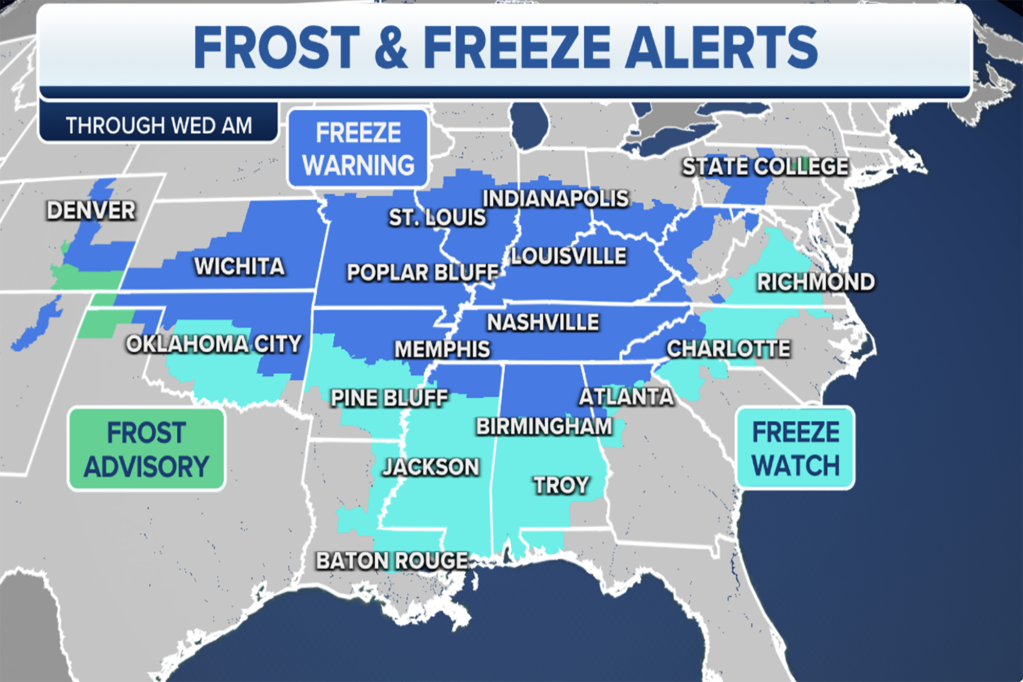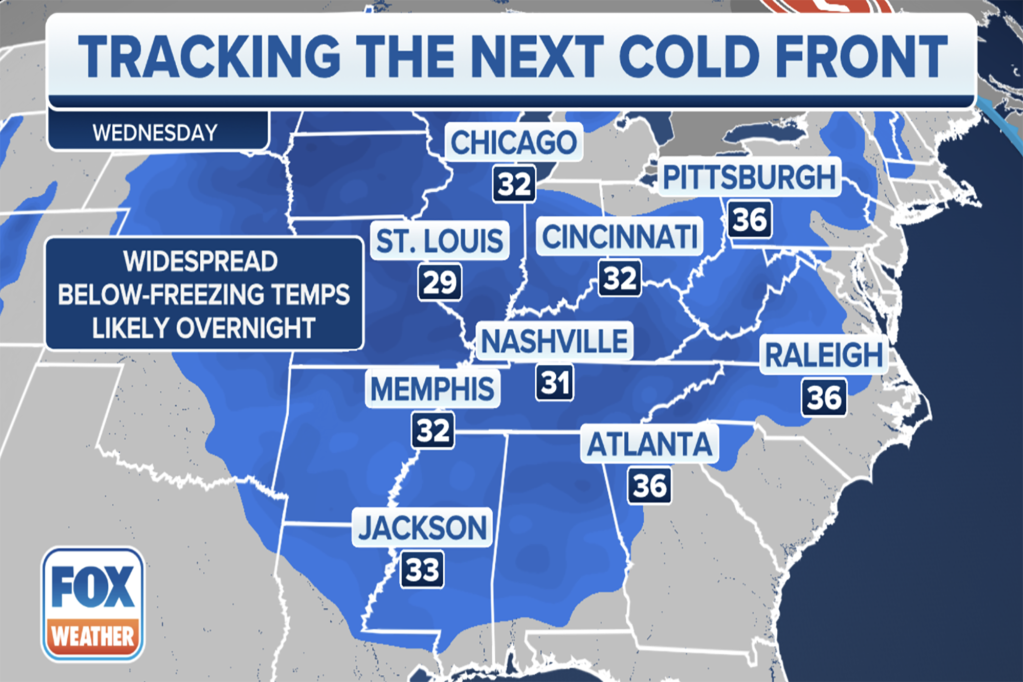Freeze alerts issued, as coldest air of season invades Midwest, South, East
The coldest air so far this fall is invading a widespread area of the Midwest, South and East, placing millions at risk of frosts and freezes this week as a powerful storm system also brings rounds of snow, rain and gusty winds from the Great Lakes to the Northeast.
A strong low-pressure system being tracked by the FOX Forecast Center is responsible for ushering in the widespread chilly air mass, which could make it all the way to the Gulf Coast by midweek.
This early-season cold snap will provide the lowest temperatures since April in many areas, with more than 180 million people estimated to see temperatures of at least 10 degrees below average on Tuesday and Wednesday.
The cold air started to move into the country out of Canada on Monday, and Tuesday and Wednesday are when the chill will be felt by nearly the entire eastern half of the nation.
“Part of the reason why this is happening is because we have a dip in the jet stream,” FOX Weather meteorologist Jason Frazer said. “That is essentially allowing all of that cold, Canadian air to sneak down.”

How low will temperatures go?
The cold air will mean both morning low temperatures and afternoon highs will be much colder than average across the Midwest, South and East.
The FOX Forecast Center expects more than 60 million people from the Canadian border to the Southeast will experience below-freezing temperatures Tuesday and Wednesday mornings.
Morning lows near or below 32 degrees are expected as far south as Nashville and Memphis in Tennessee and Birmingham and Huntsville in Alabama. A freeze would be these cities’ first of the season.
Along the Interstate 95 corridor in the Northeast, low temperatures will generally remain above freezing, but near- or below-freezing temperatures are expected across the interior Northeast and northern New England.

This cold air invasion has prompted the National Weather Service to issue Freeze Watches and Warnings for more than 75 million Americans across the Midwest, South and East.
According to the FOX Forecast Center, the annual growing season will likely end in many areas because of the likelihood of temperatures dropping to near or below 32 degrees.
High temperatures will be stuck in the 40s from the northern Plains and Upper Midwest to the interior Northeast.
While not as cold, afternoon highs will still be chilly across the rest of the Midwest and into the East, with temperatures remaining in the 50s from the Interstate 95 corridor in the Northeast into parts of the Southeast.
In fact, more than three dozen record-cold highs could be tied broken Tuesday from the Mississippi and Ohio valleys to the Southeast, followed by almost two dozen additional record-cold highs Wednesday across the Southeast all the way to Florida.
“By the end of Tuesday, we are going to end up seeing the majority of you across even the Southeast impacted, and once that happens, we will end up seeing temperatures anywhere from 15 to upwards of 20 degrees below where they should be,” Frazer said.
The cold temperatures in combination with gusty winds over the relatively warmer Great Lakes will establish a pattern for lake-enhanced snow and rain showers from the Great Lakes to parts of the Northeast through midweek.
“The first half of the workweek looks very winter like for the Great Lakes,” FOX Weather meteorologist Britta Merwin said.
Cities such as Chicago, Milwaukee, Pittsburgh, Cleveland and Columbus in Ohio and Syracuse in New York will all have the potential for rain that could mix with a bit of wet snow, though little or no accumulation is expected due to warm ground temperatures and air temperatures hovering above freezing.
Parts of the Upper Peninsula of Michigan already saw more than a foot and a half of snow by Monday evening.
And for Chicago and cities across northern Illinois, they saw flurries that marked their first snow of the season.
The potential snowfall ranks on the lowest possible scale of the National Oceanic and Atmospheric Administration’s Winter Storm Severity Index (WSSI).
This index considers various data sources to depict how significant the impacts could be, and right now, the only suggestive action is for travelers to drive carefully. The snow should not have a significant impact on daily life.
The heaviest bands of lake-effect snow will remain focused over the Upper Peninsula of Michigan and far northern Wisconsin, where the first significant snowstorm of the season is expected.
Winter Storm Warnings, Winter Storm Watches and Winter Weather Advisories have been issued for these areas into Tuesday morning.
Read the full article Here


